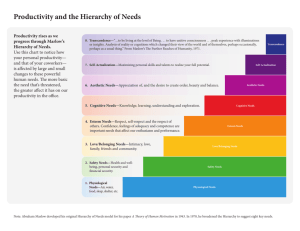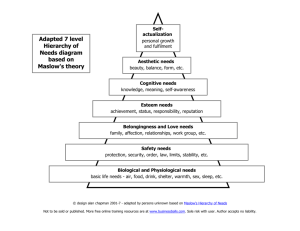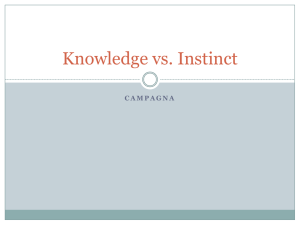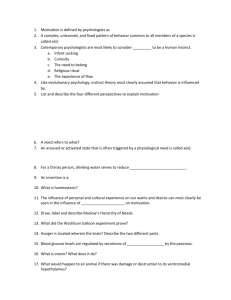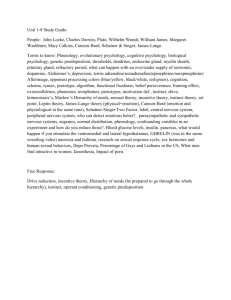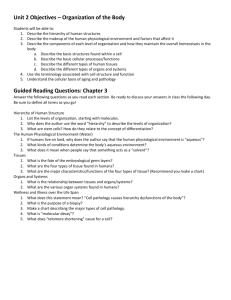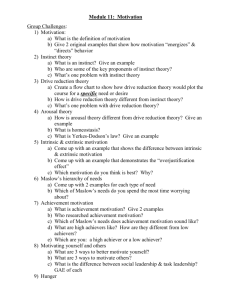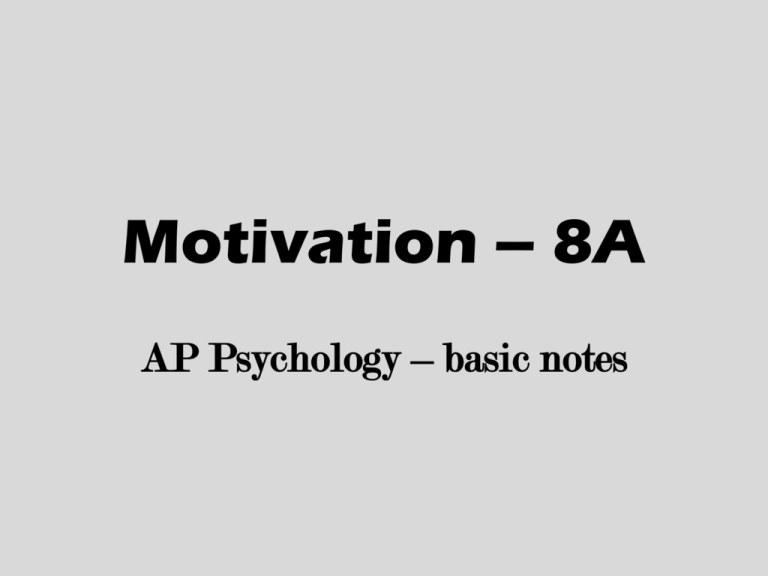
Motivation – 8A
AP Psychology – basic notes
Human Reactions
What is Motivation?
• Motivation = The process of
starting, directing, and maintaining
physical and psychological activities;
includes mechanisms involved in
preferences for one activity over
another and the vigor and persistence
of responses
• APA Website Glossary
Instinct Defined
• Instinct = a largely inheritable
and unalterable tendency of an
organism to make a complex
and specific response to
environmental stimuli without
involving reason
(Survival & Unlearned)
Instinct Theory
• Instinct =
states that
motivation is the result of
biological, genetic programming.
Thus, all beings within a species
are programmed for the same
motivation
• Studies by William James
Instinct List - James
1. Sneezing
2. Coughing
3. Biting
4. Crying
5. Hiccupping
6. Vomiting
7. Fear
**William James (his ideologies)
Human Reactions
Evolutionary Theory
Evolutionary = emotional responses are based
upon innate human instincts
Five domains:
(a) the instinct of self-protection
(b) the need of mating (off-springs)
(c) the building of relationship
(d) the coalition to create larger societal bonds
(e) the creation of large, symbolic, cultural system
Genetic, Social, and General Psychology Monographs
(Darwin – facial/nonverbal)
Drive Reduction
• Drive Reduction = linked behavior to
the desire to reduce strain produced
by primary (biological) or secondary
(acquired) drives.
• Many psychologists believed that all
motivation depended upon the
pleasure experienced when basic
needs are met.
• A person who is hungry, EATS
(usually what is available and they
like)!!
Hierarchy of Needs
Hierarchy suggests that
people are motivated to
fulfill basic needs before
moving on to other needs
Book by Maslow
(Personality and
Motivation - 1954)
Hierarchy of Needs
Hierarchy of Needs
Levels of Hierarchy
1.) Physiological Needs = most basic
needs that are vital to survival, such as
the need for water, air, food and sleep.
Most basic and instinctive
needs in the hierarchy because all needs
become secondary until these
physiological needs are met.
2.) Security Needs = Safety and Security.
Examples of security needs include a
desire for steady employment, health
insurance, safe neighborhoods, and
shelter from the environment.
Levels of Hierarchy
3.) Social Needs = belonging, love and affection.
Maslow considered these needs to be less basic
than physiological and security needs.
Relationships such as friendships, romantic
attachments and families help fulfill this need
4.) Esteem Needs = include the need for things
that reflect on self-esteem, personal worth, social
recognition and accomplishment (after the first
three needs have been satisfied)
5.) Self-actualizing Needs = highest level of
Maslow’s hierarchy of needs. Self-actualizing
people are self-aware, concerned with personal
growth, less concerned with the opinions of
others and interested fulfilling their potential
**(Hard to attain)
Homeostasis
• Balance; Stability; Rhythm
Definition = Constancy
or equilibrium of the internal
conditions of the body
Hunger/Love
Hunger
Physiological = stomach contraction;
glucose levels; insulin; fatty-acid;
heat production
Psychological = external & internal
stimulus
Social & Cultural Cues
Human Reactions
Eating Disorders
Anorexia = a person weighing less than 85 percent
of her or his expected weight but still controls
eating because of a self-perception of obesity
Stems from: Physical and Emotional issues:
CONTROL ISSUES- ANXIETY
Bulimia = eating disorder characterized by binge
eating followed by measures to purge the body of
the excess calories
Stems from: Physical and Emotional issues:
CONTROL vs. EXCESS
Obesity in US
•One in Five children ages 6-17 are
considered obese in the U.S.
•Increased risk for: heart disease, diabetes,
depression…
•Physical = stress on body; issues with
glands (adrenal; thyroid, pituitary)
Psychological = social stigma; bullying;
loneliness
Losing Weight
• Fad Diets
• Unrealistic Goals
• Quick Results
• Maintain & Goal Set
• Change Eating
• Exercise
William Masters & Virginia Johnson
Started work on how
humans processed
(physically and
mentally) the actions
of sex at Washington
University in St. Louis
during the late 1950s
to early 1960s before
opening up their own
research facility (1968)
– The Masters and
Johnson Institute
(renamed in 1978)
Sexual Response Cycle
Humans are motivated to have sex to:
reproduce and for pleasure
Definition: sequence of physical and
emotional changes that happen as a
person becomes sexually aroused and
participates in sexually stimulating
activities, including intercourse and
masturbation. (William Masters & Virginia Johnson)
(Webster Medical Dictionary)
The sexual response cycle has four phases:
excitement, plateau, orgasm and resolution
Sexual Response Cycle
Hormones
Two purposes: development of human body
and increase desire for sexual contact
Females = estrogen is the primary hormones
which cycles through the process of ovulation
Males = testosterone which occurs at more
sporadic and frequent intervals
Both males and females have each hormones
(estrogen & testosterone) – the rates vary
amongst the genders.
Studies = when sex offenders were given birth
control (Depa Provera - progesterone) made
some offenders have decreased sexual
behaviors (Money, J.)
Gender & Sex
Men = visual
Females = tactile
Brain = dreams/imaginations
Adolescence
Teens reasons for sexual activity:
1.Lack of communication (STDS and HIV)
2.Unprepared / Guilt
3.Alcohol abuse
4.Media’s representation of sex (15 images per
show and more representation of oral sex)
Teens reasons to wait:
1.Higher level of intelligence/education
2.Religious involvement/Moral standards
3.Father involvement
4.Service learning - volunteering
Sexual Orientation
Definition= sexual preference for members of the
same sex or opposite sex
•Heterosexual = attraction to members of the opposite sex
•Homosexual = attraction to members of the same sex
•Bisexual = attraction to members of both sexes
Simon Levay = work on size of brain and connection with
homosexuality (males that had homosexual tendencies had
the same size hypothalamus as straight women) – Highly
Debatably (DNA is being examined more)
Work with lesbian brain resulted some comparison with
heterosexual males but sample groups were to small to be
valid. (Ivanka Savic)
Love and Belonging
Who said …. “We are social animals.”
Aristotle – Nichomachean Ethics - how men should best live
Our psychological sense of well being is based on the
following three concepts:
Relatedness / Autonomy / Competence
Chain migration encourages the placement of:
Similar groups or family member is the same community
Who said….” ostracism weaves through case after
case of school of violence”
Social Psychologist – Kipling Williams
Love and Belonging
Innate at first (babies) – protection
Many psychologists cite and study that children
need love to grow physiological & psychological
*John Bowlby and Mary Ainsworth
Social – want to belong (peer groups) and group
conformity (more theories in the Social Psych
unit)
Love and Belonging
Ostracism and Shame = used for social
punishment (girls use more)
Varying forms: Cyber-ostracism or Retaliation
Ostracism has both physical (anterior cingulate
cortex = back portion of the frontal cortex) and
psychological impact (isolation and
worthlessness).
Human Reactions
Extrinsic vs. Intrinsic
Extrinsic - motivated to perform specific
behaviors/actions to
achieve/receive promised
outside rewards or to avoid
punishment from other
Intrinsic - feeling of personal satisfaction
from the activity or the
performance of the activity (done for joy
of activity)

